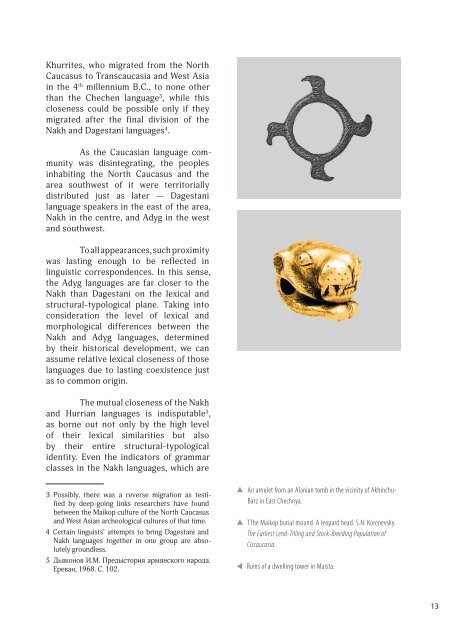The Diversity of the Chechen culture: from ... - unesdoc - Unesco
The Diversity of the Chechen culture: from ... - unesdoc - Unesco
The Diversity of the Chechen culture: from ... - unesdoc - Unesco
You also want an ePaper? Increase the reach of your titles
YUMPU automatically turns print PDFs into web optimized ePapers that Google loves.
Khurrites, who migrated <strong>from</strong> <strong>the</strong> North<br />
Caucasus to Transcaucasia and West Asia<br />
in <strong>the</strong> 4 th millennium B.C., to none o<strong>the</strong>r<br />
than <strong>the</strong> <strong>Chechen</strong> language 3 , while this<br />
closeness could be possible only if <strong>the</strong>y<br />
migrated after <strong>the</strong> final division <strong>of</strong> <strong>the</strong><br />
Nakh and Dagestani languages 4 .<br />
As <strong>the</strong> Caucasian language community<br />
was disintegrating, <strong>the</strong> peoples<br />
inhabiting <strong>the</strong> North Caucasus and <strong>the</strong><br />
area southwest <strong>of</strong> it were territorially<br />
distributed just as later — Dagestani<br />
language speakers in <strong>the</strong> east <strong>of</strong> <strong>the</strong> area,<br />
Nakh in <strong>the</strong> centre, and Adyg in <strong>the</strong> west<br />
and southwest.<br />
To all appearances, such proximity<br />
was lasting enough to be reflected in<br />
linguistic correspondences. In this sense,<br />
<strong>the</strong> Adyg languages are far closer to <strong>the</strong><br />
Nakh than Dagestani on <strong>the</strong> lexical and<br />
structural-typological plane. Taking into<br />
consideration <strong>the</strong> level <strong>of</strong> lexical and<br />
morphological differences between <strong>the</strong><br />
Nakh and Adyg languages, determined<br />
by <strong>the</strong>ir historical development, we can<br />
assume relative lexical closeness <strong>of</strong> those<br />
languages due to lasting coexistence just<br />
as to common origin.<br />
<strong>The</strong> mutual closeness <strong>of</strong> <strong>the</strong> Nakh<br />
and Hurrian languages is indisputable 5 ,<br />
as borne out not only by <strong>the</strong> high level<br />
<strong>of</strong> <strong>the</strong>ir lexical similarities but also<br />
by <strong>the</strong>ir entire structural-typological<br />
identity. Even <strong>the</strong> indicators <strong>of</strong> grammar<br />
classes in <strong>the</strong> Nakh languages, which are<br />
3 Possibly, <strong>the</strong>re was a reverse migration as testified<br />
by deep-going links researchers have found<br />
between <strong>the</strong> Maikop <strong>culture</strong> <strong>of</strong> <strong>the</strong> North Caucasus<br />
and West Asian archeological <strong>culture</strong>s <strong>of</strong> that time.<br />
4 Certain linguists’ attempts to bring Dagestani and<br />
Nakh languages toge<strong>the</strong>r in one group are absolutely<br />
groundless.<br />
5 Дьяконов И.М. Предыстория армянского народа.<br />
Ереван, 1968. С. 102.<br />
An amulet <strong>from</strong> an Alanian tomb in <strong>the</strong> vicinity <strong>of</strong> Akhinchu-<br />
Barz in East Chechnya.<br />
T<strong>The</strong> Maikop burial mound. A leopard head. S.N. Korenevsky.<br />
<strong>The</strong> Earliest Lend-Tilling and Stock-Breeding Population <strong>of</strong><br />
Ciscaucasia.<br />
Ruins <strong>of</strong> a dwelling tower in Maista.<br />
13

















